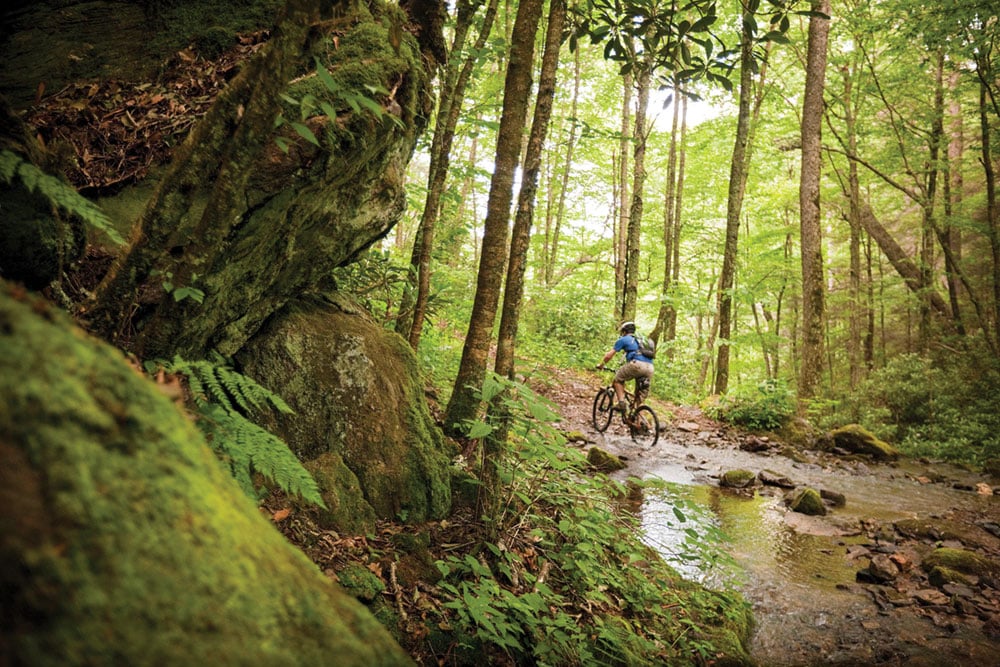Here’s something you already know: Land in the mountains is crazy expensive and hard to find. Prices are skyrocketing, making it tougher than ever to own a slice of heaven.
But here’s something you may not know: you already own one million acres of mountain property.
Your property includes cascading waterfalls, ancient forests, and the highest mountains in the East. You can hike thousands of miles of trails and paddle, fish, and swim in its pristine streams.
You share ownership equally with every other American, and you pay your staff—the U.S. Forest Service—to manage the property. They maintain the trails and enforce the rules that you make.
Every 20 to 30 years, you write a plan that describes how your property should be managed. You get together with the other owners to hash it out, and your staff writes it all down. This plan is the most important document of your property. It spells out the rules for your property and decides how your taxes are spent.
After eight years of planning, you and 92 percent of your co-owners told the Forest Service that you wanted more protected areas and less logging in your one-million-acre Pisgah-Nantahala National Forest. Unfortunately, your staff—the Forest Service—just published a forest plan that does the exact opposite.
The newly released Pisgah-Nantahala National Forest Plan will quadruple logging while weakening protections for the forest’s most important recreation and conservation areas.
The Pisgah-Nantahala National Forest is the most visited national forest in the country. Nearly seven million people visit it each year, and nearly all of those visitors are nature-loving outdoor enthusiasts: hikers, mountain bikers, paddlers, climbers, anglers, trail runners, dog walkers, and nature seekers. Overwhelmingly, these users have made it clear: they want more of the forest protected. A record-setting 22,000 public comments flooded the Forest Service, and overwhelmingly they supported more protected areas and stronger protections for the forest.
Yet the Forest Service mostly disregarded the public input they received and instead has issued a forest plan that favors the extractive interests of the one percent. The plan quadruples logging, roadbuilding, and herbicide use. It targets thousands of acres of old-growth forests for timber harvests. It allows logging in the Appalachian Trail corridor, the Mountains-to-Sea Trail corridor, the Trail of Tears National Historic Trail, and other celebrated and beloved footpaths.
An Easy Win
Perhaps the most glaring example of the Forest Service dismissing public input is the proposed Craggy National Scenic Area. This 18,000-acre waterfall wonderland—only 15 miles from downtown Asheville—would protect the panoramic views from Craggy Gardens, the most popular and photographed spot along the Blue Ridge Parkway.
Craggy has widespread public, political, stakeholder, and local community support. The Forest Service received more comments supporting Craggy than all other places combined. Even the timber industry endorses the Craggy National Scenic Area.
Yet the Forest Plan places over 4,000 acres of Craggy in its highest-priority logging designations. Craggy’s ancient forests, headwaters, trout streams, drinking water sources, and two iconic trails—the Mountains to Sea Trail and Snowball Trail—are now targeted for logging.
The Forest Service did one thing right: it gets big props for providing a lot of opportunity for public input on the Forest Plan. And the public responded with a record-setting number of comments. Unfortunately, the Forest Plan chose to mostly ignore them.
An Even Easier Win
Another missed opportunity was the Pisgah Nantahala Forest Partnership. This coalition of 30 diverse organizations includes hunting groups, timber industry representatives, and recreation and conservation organizations. For five years, these groups met to hammer out a compromise agreement that balances timber and conservation.
The Partnership Agreement was a gift handed to the Forest Service. This Agreement would ensure that the next 30 years of forest management was not mired in conflict and litigation. Instead, forest management could be mutually supported by everyone.
The Forest Service flat-out refused the Partnership Agreement.
Failing Grade
Not surprisingly, the Forest Plan has been panned by nearly everyone. A coalition of 100 organizations and businesses teamed up to create the Pisgah-Nantahala Forest Plan Report Card. The report card synthesizes the 2,000-page forest plan into 10 key issues that matter most to forest users, like trails, water, recreation, and protected areas. The report card grades the plan on those topics. The plan gets passing grades for a few issues, but overall, it flunks.
Fortunately, there’s summer school—and a cheat sheet. The report card offers an Answer Key of simple solutions for the forest plan, including protecting all of the Craggy National Scenic Area and adopting the Nantahala Pisgah Forest Partnership Agreement.
The Forest Service had it on the goal line, and they fumbled. But there’s still time left on the clock. The Forest Service can still fix the plan before it issues its final decision this summer.
The Forest Plan has already set another record: most objections. The Forest Service has been flooded with legal objections to its forest plan from organizations, businesses, and individuals.
This 1.1-million-acre forest belongs to all of us. Let’s manage it for the greatest good by prioritizing recreation and conservation. The most popular national forest in the country is worth far more standing than cut down.
Cover photo: A mountain biker rides the Staire Creek Trail in the Pisgah National Forest. photo by Steven McBride
Will Harlan is senior campaigner and scientist with the Center for Biological Diversity.








